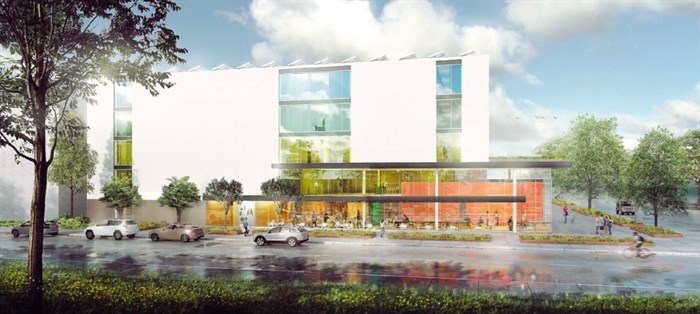This Kelowna mini-storage project will eat carbon with its walls made out of hemp

In an environmentally sensitive world it’s not unusual for developers to tout the fact that their projects will have low carbon footprints.
Vancouver-based Ulmus Development Ltd. CEO Don Redden is going a step further and is trying to create a Kelowna building that not only has no carbon footprint but will actually suck carbon from the air for the next 50 to 100 years.
He plans to build a 112,000 square foot, five-storey mini-storage designed to appeal to downtown highrise residents and businesses. It’s right next to what could be a major development on the Tolko lands in the downtown North End.
READ MORE: Kelowna moving quickly to plan redevelopment of Tolko mill site on Okanagan Lake
“This is a pilot project for us,” Redden told iNFOnews.ca. His company is more familiar with residential work. “We wanted to find a location that is near where people live, in highrises in particular, because there’s a lot of self-storage but it’s usually on the periphery of a city in an area that you’ve got to drive to.
“People need storage year-round now because they’re living in smaller and smaller apartments and condominiums and we don’t want people driving to get their golf clubs or driving to get their skis or their Christmas decorations because that’s just putting more CO2 into the atmosphere.”
The building, which had its development permits approved by Kelowna city council earlier this week, is at the southwest corner of Bay Avenue and Ellis Street.
A planning process is in place for the nearby 42-acre Tolko property that is seen as one of the prime development sites in Canada.
And it’s right across the street from the B.C. Tree Fruits building that just sold to the Mission Group for $24 million and is expected to bring hundreds of millions of dollars in redevelopment to that site alone.
READ MORE: $24M sale of Kelowna waterfront property will trigger hundreds of millions in economic impact
That may be a great location for what is being tentatively called EcoLock Self Storage but it’s got a lot of unique features that should make it stand out in other ways.
First of all, in an effort to meet high environment standards (like “Petal-level Living Building Challenge” and the Canada Green Building Council Zero Carbon Pilot Program) it’s going to be powered by solar panels that cover the entire roof, generating about 200,000 kilowatt hours per year or 105% of the expected electrical needs for the building.
The idea is to put excess power generated in the summer into the electrical grid and draw on it during the cloudier winter days.
That 105% could have been greater but they ran out of roof space, Redden said.
A highly efficient “variable refrigerant flow” heating and cooling system will provide a rare feature for self-storage facilities – air conditioning.
“We thought, we’ve got a lot of business clients, homeowners who may have artwork,” Redden said. “You don’t want to have their stuff roasting in the summer and freezing in the wintertime.”
The elevator will be equipped with a generator that will create electricity to be stored in batteries as it descends. While that’s not enough to power the upward trip, it does lower the draw on the solar panels.
That’s all well and good for being carbon neutral, but it’s the hemp-based interior walls that actually suck in carbon over time.
“This is a new product developed in Canada,” Redden said. “It’s a structural hemp block. It looks like a Lego.”
The Just BioFibre blocks are made in Alberta from fast-growing hemp that sequesters about 6.5 kg of carbon from the plant for each block that measures roughly 8 x 10 x 21 inches.
“Most of it is from the leftover stalk from the industrial hemp plant that has carbon in it,” Redden explained. “That’s the material that surrounds the structural component inside. Then it’s mixed with some lime and some secret sauce that holds it together. Over time, that mixture ossifies (petrifies) and it brings in more carbon over a 50- to 100-year period.”
That’s only about half a kilogram of carbon over time for each block but it is reducing carbon.
While it has great structural strength, the Just BioFibre blocks have mainly been used in houses so the EcoLock building is a bit of a commercial guinea pig. For that reason, the structural outside walls will be standard metal panels with R40 insulation.
Construction costs are expected to be about five per cent higher than a typical building of this type but the energy savings will repay that in about eight years, Redden said.
Construction on the site was originally slated for late 2019 but, as COVID hit, Redden pulled back and re-evaluated what the market needed.
Initially there were co-work spaces for about 45 people but, with COVID, Redden doesn’t think there’s a market right now for people sharing space. That component has been dropped in exchange for a large lobby where people can still do things like check their email or organize their business materials.
“The problem with most self-storage is they’re ugly, they don’t look good at night, they’re not safe to be around because they’re dark all the time,” Redden said. “So, we want to activate the ground floor. We have a very large lobby, lots of windows. We think it’s a very attractive building so it’s going to complement the future neighbourhood.”
Plans are to start construction in the summer and complete it 13 months later.
If this works in Kelowna, Redden sees the concept spreading throughout North America, not only as a business model but as an educational tool.
“There’s a lot of other technologies that we use so, when you walk in, there will be little placards that describe how the building actually functions so maybe people can go, ‘okay, that’s interesting. Maybe I can use that idea in my home or try that in my business,’” Redden said. “It’s got to inform, educate and perform.”
To contact a reporter for this story, email Rob Munro or call 250-808-0143 or email the editor. You can also submit photos, videos or news tips to the newsroom and be entered to win a monthly prize draw.
We welcome your comments and opinions on our stories but play nice. We won't censor or delete comments unless they contain off-topic statements or links, unnecessary vulgarity, false facts, spam or obviously fake profiles. If you have any concerns about what you see in comments, email the editor in the link above.



